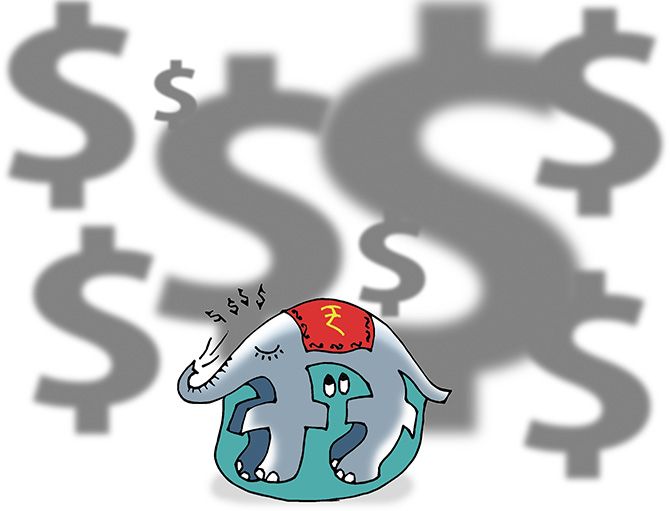Among the current FTAs with significant trade deficits for India, five are with countries from the 10-nation Asean bloc.
Exports to the 10 economies stood at $ 37.4 billion in 2018-19, up by 9% year on year.
On the other hand, imports were higher at $ 59.31 billion, up by 25% from the previous year's $ 47.13 billion.
Illustration: Dominic Xavier/Rediff.com

Amid rising clamor among domestic businesses against India’s existing Free Trade Agreements (FTAs), the revenue department has started assessing shortcomings of each deal, which have led to spiraling trade deficit.
The Finance Ministry took notice after officials found that India’s major FTAs constituted only 11 per cent of the total trade and up to 23 per cent of trade deficit.
While the commerce department would frame the updated trade rules for each FTA, whenever revised, the revenue department has started assessing its scope and nature.
Officials have pointed out that India’s trade balance is turning more unfavourable for most FTAs.
It has doubled since 2011 to Rs 12.86 trillion in 2018-19.
Among the current FTAs with significant trade deficits for India, five are with countries from the 10-nation Association of the Southeast Asian Nations (Asean) bloc.
In 2009, India had signed a multilateral FTA with the Asean bloc itself, which has seen imports go up at a much faster clip than exports.
Exports to the 10 economies stood at $ 37.4 billion in 2018-19, up by 9 per cent year on year.
On the other hand, imports were higher at $ 59.31 billion, up by 25 per cent from the previous year's $ 47.13 billion.
Earlier this month, India and the Asean agreed to review the pact amid criticism from the domestic industry.
Low utilisation
As a result of lower import duties that had to be implemented in the deal, revenue foregone has more than doubled to nearly Rs 26,000 crore in 2018-19, the Finance Ministry had said earlier this year.
Equally, India has had to forego revenue to the tune of Rs 7,327 crore for its FTA with South Korea and Rs 4,053 crore for the trade deal with Japan.
Using the Asean FTA as a model due to its range goods covered and volume of trade, a study by the NITI Aayog has said that utilisation rate of current trade deals by Indian exporters remain very low (between 5 per cent and 25 per cent).
Sectors where trade deficit has worsened account for 75 per cent of exports to Asean, while trade surplus sectors have shown only marginal improvement, it had added.
“Overall, it can be concluded that India’s quality of trade has not improved under the AIFTA (Asean-India FTA),” it had said.
Under the initial agreement, Asean member states and India agreed to open their respective markets by progressively reducing and eliminating import duties on 76.4 per cent of all goods.
Back then, India had offered around 9,000 products for complete elimination of tariffs, excluding about 10 per cent of its exports from tariff reduction.
Experts have pointed out that Thailand, the Philippines, Myanmar, Brunei, and Vietnam have excluded more of their exports as compared to India.
RCEP fears
On the other hand, the government fears total revenue foregone may hit as high as Rs 60,000 crore for the proposed Regional Comprehensive Economic Partnership (RCEP) deal once it goes live.
RCEP is India’s most ambitious trade pact under negotiation.
Based on India’s existing FTA with Asean, the RCEP will include New Zealand, Australia, Japan, South Korea, and most importantly, China.
Under planning since 2012, the talks have seen little movement since partner nations have been unwilling to concede on crucial issues.
This includes the market access for foreign goods and reduction of import duties on them, discussion areas where India is gravely cautious since manufacturing powerhouse China is part of the arrangement.
India’s repeated clashes with China, apart from richer nations such as Australia and Japan, on tariff reduction has led to a pushback from the Asean bloc, which has been adamant on deciding the key outline of the pact by the end of 2019.
Commerce and industry minister has warned that while the government would strive to protect the interests of a majority of industries, the overall discussion could not be hijacked by one or two sectors.











